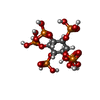+Search query
-Structure paper
| Title | Molecular mechanism of N-terminal acetylation by the ternary NatC complex. |
|---|---|
| Journal, issue, pages | Structure, Vol. 29, Issue 10, Page 1094-11104.e4, Year 2021 |
| Publish date | Oct 7, 2021 |
 Authors Authors | Sunbin Deng / Leah Gottlieb / Buyan Pan / Julianna Supplee / Xuepeng Wei / E James Petersson / Ronen Marmorstein /  |
| PubMed Abstract | Protein N-terminal acetylation is predominantly a ribosome-associated modification, with NatA-E serving as the major enzymes. NatC is the most unusual of these enzymes, containing one Naa30 catalytic ...Protein N-terminal acetylation is predominantly a ribosome-associated modification, with NatA-E serving as the major enzymes. NatC is the most unusual of these enzymes, containing one Naa30 catalytic subunit and two auxiliary subunits, Naa35 and Naa38; and substrate selectivity profile that overlaps with NatE. Here, we report the cryoelectron microscopy structure of S. pombe NatC with a NatE/C-type bisubstrate analog and inositol hexaphosphate (IP), and associated biochemistry studies. We find that the presence of three subunits is a prerequisite for normal NatC acetylation activity in yeast and that IP binds tightly to NatC to stabilize the complex. We also describe the molecular basis for IP-mediated NatC complex stabilization and the overlapping yet distinct substrate profiles of NatC and NatE. |
 External links External links |  Structure / Structure /  PubMed:34019809 / PubMed:34019809 /  PubMed Central PubMed Central |
| Methods | EM (single particle) |
| Resolution | 3.16 Å |
| Structure data | EMDB-23110, PDB-7l1k: |
| Chemicals |  ChemComp-IHP:  ChemComp-CMC: |
| Source |
|
 Keywords Keywords | TRANSFERASE / NatB / NAA20 / NAA25 |
 Movie
Movie Controller
Controller Structure viewers
Structure viewers About Yorodumi Papers
About Yorodumi Papers






 homo sapiens (human)
homo sapiens (human)